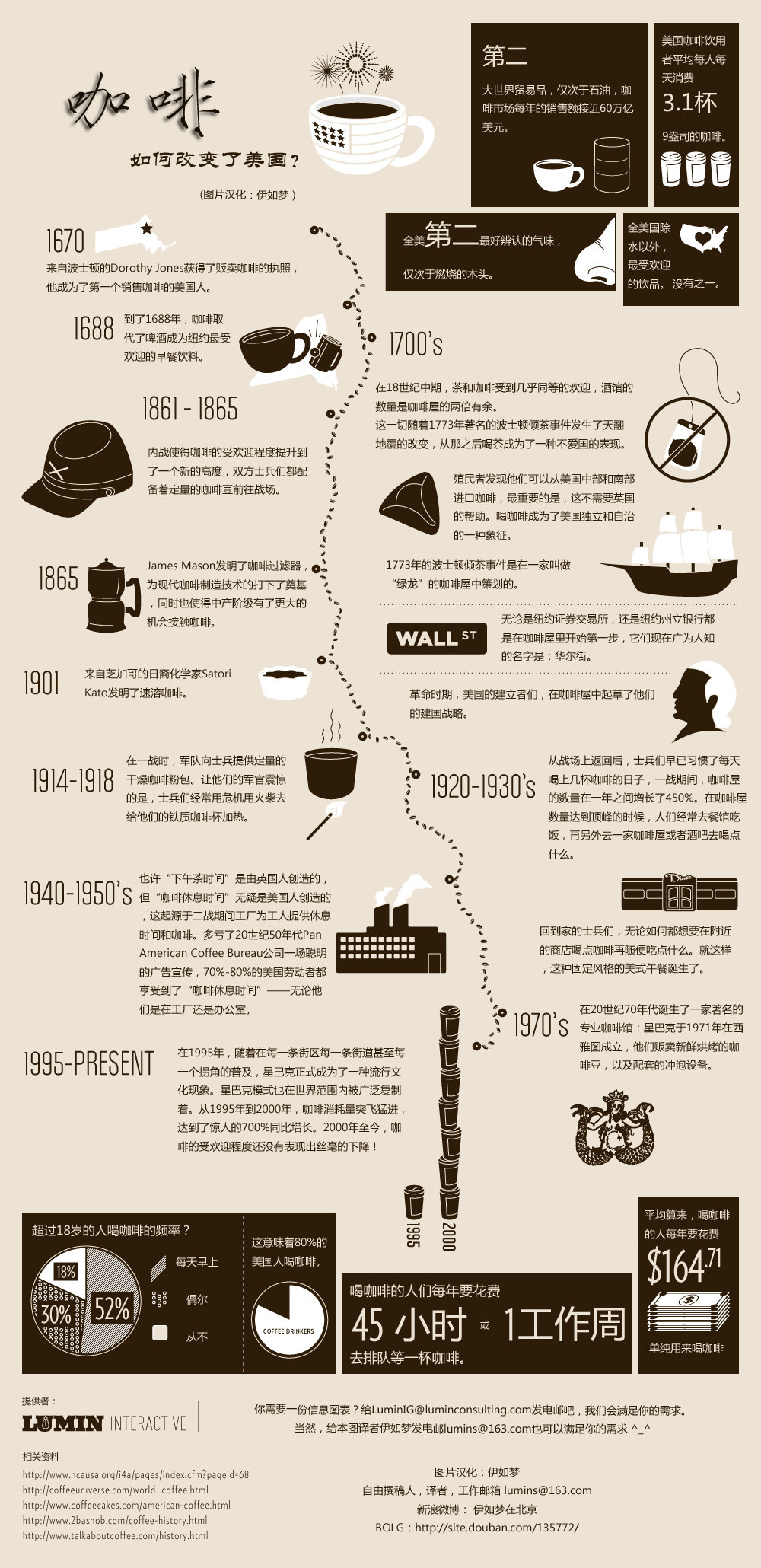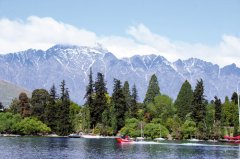Coffee changes American culture: becoming a symbol of independence and workers' stimulant

(click on the image above to view the big picture / translation website)
NetEase reported on January 31 that coffee is one of the most popular drinks in the world and one of the most traded goods in the world. I've been writing a book about coffee recently, but I've been hesitant: I don't know how many coffee consumers really want to know about the things behind coffee.
Many of us like to savor the taste and feeling of a cup of hot Scotch coffee, not to mention the satisfaction of the slightly affected rituals when tasting coffee, but about the beans behind a cup of coffee, how many people really want to know?
There has been a long discussion about caffeine, but science still can't fully explain its effect on the human body. not to mention how the nearly 100 other biological ingredients in the latte presented to you affect the human body when they combine with each other. Much of the debate revolves around the health effects of coffee on the human body, and related academic reports are often contradictory.
There is also a complex and delicate relationship between coffee, culture and the environment. If we adopt the correct planting method, coffee can help protect the natural environment of more than half of the forest or even the whole forest, and the value of the natural environment is inestimable by the traditional way of growing coffee. Coffee farming can provide jobs for people in the countryside. similarly, coffee is a major export commodity for many developing countries.
But if the method is not correct, coffee farming can directly lead to adverse factors such as extinct rainforests, large amounts of pesticides, coffee workers suffering from related occupational diseases, ruthless exploitation by coffee plantation owners, and degradation of the natural environment. Many certified coffee planting schemes announce the market value of their products to the world by overpressing and forcibly increasing output. I have written a lot about fair and free trade, nature conservation, organic cultivation, combined rainforest planting and other similar schemes in the coffee growing industry.
People who are crazy about coffee tend to stubbornly prefer a certain brand of coffee beans they like or a specified coffee bean originating in a particular country, or so fine that each ingredient is added or cut with a fixed proportion of mixed flavor. As the old saying goes, there are three things to pay attention to good coffee: first, we should pay attention to the planting place, second, we should pay attention to the people who grow coffee, and third, we should ensure that there are no chemical additives in the cultivation of coffee. nowadays, such an old proverb can no longer keep up with the trend of the times-if growers want to pay attention to the complete absence of chemical additions, to ensure purebred planting, fair trade, combined rainforest planting, and so on, the cost is too high.
Coffee also has a strong cultural and historical background, whether in its origin or in the world. Valuable coffee seeds have been smuggled to distant jungle countries for illegal large-scale gardening, and coffee houses have gradually become another center for people to gather about globalization and cooperative responsibility. refuge for political debates such as self-possession. Activists once set up pickets at the first Starbucks in our college town, and once they yelled at me, "are you really here to spend so much money for a cup of coffee?" I told them I was just here for a cup of hot chocolate, but they still had an expression of mistrust, and the display glass on the face of the coffee shop was smashed a week later.
Although I'm a little sensitive to caffeine, it doesn't affect my occasional cup of decaffeinated coffee. I read the data chart with great interest. Drew Hendricks, a casual acquaintance of mine, who does some social media authoritative work for the company that produced this chart, asked me if I was interested in using the chart. This is how he described it:
Although coffee originated in North Africa, it plays a very important role in the United States.
Coffee was first introduced to the United States by the British, when it was regarded as a second-rate drink, especially when compared with tea, which was popular at that time. However, just after the Boston tea pouring (the Boston tea pouring took place during the political demonstration on December 16, 1773). Because the colonists in North America were dissatisfied with Britain, local residents dumped tea in Boston, Massachusetts, against the British Parliament, which eventually led to the famous American War of Independence. It is not only one of the key points of the American Revolution, but also one of the important historical events of the founding of the United States. Coffee was very popular in the United States, which was still a colony at that time. After the incident in protest against the British tea tax, drinking tea is widely regarded as an act of treason, while drinking coffee has become a symbol of independence.
Coffee continued to play an important role in American culture during the "coffee break" during World War II. After seeing the magical effect of caffeine on employees, factory owners gave employees longer breaks and even offered them coffee.
As the infographic designed by Lumin Interactive and Condor Consulting shows, coffee remains one of the most popular drinks in the United States, with nearly 80 percent of Americans being coffee drinkers. With the continuous expansion of the number and scale of coffee shops across the country, the popularity of coffee will continue to grow.
(note: Brian Clark Howard is a writer and editor at National Geographic. He has worked as an editor at The Daily Green and E/The Environmental Magazine magazines and contributed to TheAtlantic.com, FastCompany.com, MailOnline.com, PopularMechanics.com, Yahoo!, MSN and many other publications. He recently co-published his new book Build Your Own Small Wind Power System (Building your own small Wind Power system) with Kevin Shea.)
(source: NetEase Exploration author: Brian Clark Howard) responsible Editor: NN028
Important Notice :
前街咖啡 FrontStreet Coffee has moved to new addredd:
FrontStreet Coffee Address: 315,Donghua East Road,GuangZhou
Tel:020 38364473
- Prev

In the coffee popular area, the British prefer to drink tea.
The British like to drink tea, but people living around Britain are keen on another kind of drink, coffee. The Nordic region, located in the north of England, is the most coffee-hungry region in the world. The five Nordic countries occupy the first, second, third, fourth and sixth places in the ranking of coffee consumption per capita, respectively, while Belgium, which ranks eighth, faces the United Kingdom across the sea. Why are the British?
- Next

Queenstown and Coffee Culture in New Zealand
The leisurely temperament of Queenstown is similar to the coffee culture of New Zealand. The coffee in the small town coffee shop is full of ingredients with hamburger New Zealand coffee. The fragrant New Zealand winery trip is also famous for the ancient tram restaurant in Christchurch. There is also delicious coffee to provide some cafes to print their own T-shirts, postcards and so on for tourists to choose and buy Wentu / Yangcheng Evening News reporter Liu Xingtong.
Related
- How did the Salvadoran coffee industry develop in Central America?
- What exactly does the golden cup extraction of coffee mean?
- The Origin of Coffee flower
- [2023 Starbucks World Earth Day] there are more meaningful things besides free Starbucks coffee!
- What kind of coffee is there in Spain? 9 Flavors of Spanish Coffee
- Aromatic African coffee| Kenya's coffee culture and historical production area
- Liberica Coffee Bean knowledge: the characteristics of Liberian Coffee beans of the three original species of Coffee beans
- The origin and formula of Spanish latte introduces the taste characteristics of Bombon coffee in Valencia, Spain.
- How to adjust the solution of over-extracted coffee
- What is the tasting period of coffee beans? What is the period of coffee and beans? How should coffee wake up and raise beans?

